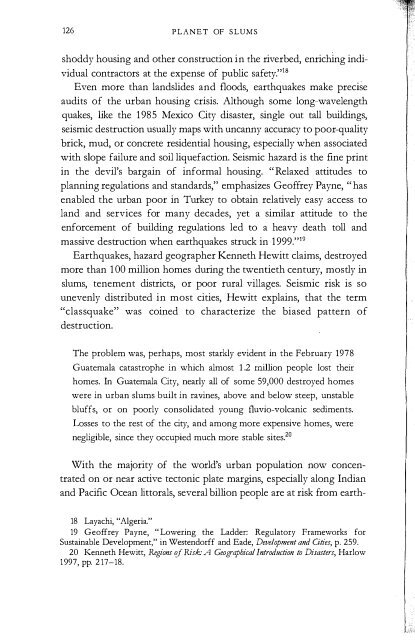Untitled - Rebel Studies Library
Untitled - Rebel Studies Library
Untitled - Rebel Studies Library
You also want an ePaper? Increase the reach of your titles
YUMPU automatically turns print PDFs into web optimized ePapers that Google loves.
126 PLANET OF SLUMS<br />
shoddy housing and other construction in the riverbed, enriching individual<br />
contractors at the expense of public safety."18<br />
Even more than landslides and floods, earthquakes make precise<br />
audits of the urban housing crisis. Although some long-wavelength<br />
quakes, like the 1985 Mexico City disaster, single out tall buildings,<br />
seismic destruction usually maps with uncanny accuracy to poor-quality<br />
brick, mud, or concrete residential housing, especially when associated<br />
with slope failure and soil liquefaction. Seismic hazard is the fine print<br />
in the devil's bargain of informal housing. "Relaxed attitudes to<br />
planning regulations and standards," emphasizes Geoffrey Payne, "has<br />
enabled the urban poor in Turkey to obtain relatively easy access to<br />
land and services for many decades, yet a similar attitude to the<br />
enforcement of building regulations led to a heavy death toll and<br />
massive destruction when earthquakes struck in 1999."19<br />
Earthquakes, hazard geographer Kenneth Hewitt claims, destroyed<br />
more than 100 million homes during the twentieth century, mostly in<br />
slums, tenement districts, or poor rural villages. Seismic risk is so<br />
unevenly distributed in most cities, Hewitt explains, that the term<br />
"classquake" was coined to characterize the biased pattern of<br />
destruction.<br />
The problem was, perhaps, most starkly evident in the February 1978<br />
Guatemala catastrophe in which almost 1.2 milJion people lost their<br />
homes. In Guatemala City, nearly all of some 59,000 destroyed homes<br />
were in urban slums built in ravines, above and below steep, unstable<br />
bluffs, or on poorly consolidated young fluvio-volcanic sediments.<br />
Losses to the rest of the city, and among more expensive homes, were<br />
negligible, since they occupied much more stable sites.2o<br />
With the majority of the world's urban population now concentrated<br />
on or near active tectonic plate margins, especially along Indian<br />
and Pacific Ocean littorals, several billion people are at risk from earth-<br />
18 Layachi, "Algeria."<br />
19 Geoffrey Payne, "Lowering the Ladder: Regulatory Frameworks for<br />
Sustainable Development," in Westendorff and Eade, Development and Cities, p. 259.<br />
20 Kenneth Hewitt, Regions if Risk: A Geographical Introduction to Disasters, Harlow<br />
1997, pp. 217-18.<br />
SLUM ECOLOGY 127<br />
quakes, volcanoes, and tsunamis, as well as from storm surges and<br />
typhoons. If the December 2004 Sumatra mega-earthquake and<br />
tsunami were relatively rare events, others are virtually inevitable within<br />
the next century. Istanbul gecekondus, for example, are the ultimate<br />
bull's-eye for the earthquakes creeping inexorably westward along the<br />
"opening zipper" of the North Anatolia transform fault system.<br />
Likewise, Lima authorities predict that at least 100 , 000 structures -<br />
mostly in the turgurios and barriadas - will collapse during the major<br />
earthquake expected sometime in the next generation.21<br />
But the urban poor do not lose much sleep at night worrying about<br />
earthquakes or even floods. Their chief anxiety is a more frequent and<br />
omnipresent threat: fire. Slums, not Mediterranean brush or Australian<br />
eucalypti as claimed in some textbooks, are the world's premier fire<br />
ecology. Their mixture of inflammable dwellings, extraordinary density,<br />
and dependence upon open fires for heat and cooking is a superlative<br />
recipe for spontaneous combustion. A simple accident with cooking<br />
gas or kerosene can quickly become a mega-fire that destroys hundreds<br />
or even thousands of dwellings. Fire spreads through shanties at<br />
extraordinary velocity, and fire-fighting vehicles, if they respond, are<br />
often unable to negotiate narrow slum lanes.<br />
Slum fires, however, are often anything but accidents: rather than<br />
bear the expense of court procedures or endure the wait for an official<br />
demolition order, landlords and developers frequently prefer the simplicity<br />
of arson. Manila has an especially notorious reputation for<br />
suspicious slum fires. "Between February and April 1993," explains<br />
Jeremy Seabrook, "there were eight major burnings in the slums, including<br />
arson attacks on Smoky Mountain, Aroma Beach and Navotas. The<br />
most threatened area is close to the docks where the container terminal<br />
is to be extended."22 Erhard Berner adds that a favorite method for what<br />
Filipino landlords prefer to call "hot demolition" is to chase a<br />
"kerosene-drenched burning live rat or cat - dogs die too fast - into an<br />
annoying settlement ... a fire started this way is hard to fight as the<br />
unlucky animal can set plenty of shanties aflame before it dies."23<br />
21 Leonard, "Lima", p. 439.<br />
22 Seabrook, In the Cities if the South, p. 271.<br />
23 Berner, Defending a Place, p. 144.


